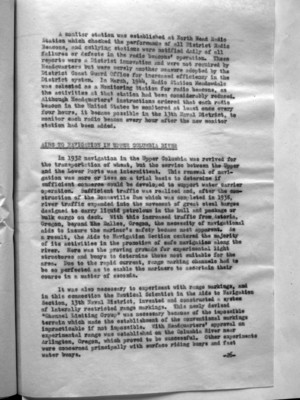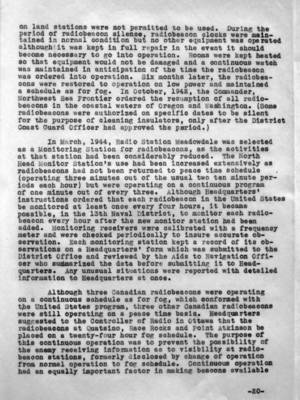Pages That Mention Radio Station Meadowdale
Coast Guard District narrative histories 1945
9
A monitor station was established at North Head Radio Station which checked the performance of all District Radio Beacons, and outlying stations were notified daily of all failures or defects in the radio beacons' operation. These reports were a District innovation and were not required by Headquarters but were merely another measure adopted by the District Coast Guard Office for increased efficiency in the District system. In March, 1944, Radio Station Meadowdale was ??? as a Monitoring Station for radio beacons, as the activities at that station had been considerably reduced. Although Headquarters' instructions ordered that each radio beacon in the United States be monitored at least once every four hours, it became possible in the 13th Naval District, to monitor each radio beacon every hour after the new monitor station had been added.
AIDS TO NAVIGATION IN UPPER COLUMBIA RIVER
In 1932 navigation in the Upper Columbia was revived for the transportation of wheat, but the servies between the Upper and Lower Ports was intermittent. This renewal of navigation was more or less on a trial basis to determine if sufficient commerce could be developed to support water carrier operation. Sufficient traffic was realized and, after the construction of the Bonneville Dam which was completed in 1938, river traffic expanded into the movement of great steel barges designed to carry liquid petroleum in the hull and package or bulk cargo on deck. With this increased traffic from Astoria, Oregon, beyond The Dalles, Oregon, the necessity of navigational aids to insure the mariner's safety became most apparent. As a result, the Aids to Navigation Section centered the majority of its activities in the promotion of safe navigation along the river. Here was the proving grounds for experimental light structures and buoys to determine those most suitable for the area. Due to the rapid current, range marking channels had to be so perfected as to enable the mariners to ascertain their course in a matter of seconds.
It was also necessary to experiment with range markings, and in this connection the Nautical Scientist in the Aide to Navigation Section, 13th Naval District, invented and constructed a system of laterally restricted range markings. This newly devised "Channel Limiting Group" was necessary because of the impossible terrain which made the establishment of the conventional markings impracticable if not impossible. With Headquarters' approval an experimental range was established on the Columbia River near Arlington, Oregon, which proved to be successful. Other experiments were concerned principally with surface riding buoys and fast water buoys.
-26-
39
on land stations were not permitted to be used. During the period of radiobeacon silence, radiobeacon clocks were maintained in normal condition but no other equipment was operated although it was kept in in full repair in the event it should become necessary to go into operation. Rooms were kept heated so that equipment would not be damaged and a continuous watch was maintained in anticipation of the time the radiobeacon was ordered into operation. Six months later, the radiobeacons were restored to operation on low power and maintained a schedule as for fog. In October, 1942, the Commander, Northwest Sea Frontier ordered the resumption of all radiobeacons in the coastal waters of Oregon and Washington. (Some radiobeacons were authorized on specific dates to be silent for the purpose of cleaning insulators, only after the District Coast Guard Officer had approved the period.)
In March, 1944, Radio Station Meadowdale was selected as a Monitoring Station for radiobeacons, as the activities at that station had been considerably reduced. The North Head Monitor Station's use had been increased extensively as radiobeacons had not been returned to peace time schedule (operating three minutes out of the usual two ten minute periods each hour) but were operating on a continuous program of one minute out of every three. Although Headquarters' instructions ordered that each radiobeacon in the United States be monitored at least once every four hours, it became possible, in the 13th Navel District, to monitor each radiobeacon every hour after the new monitor station had been added. Monitoring receivers were calibrated with a frequency meter and were checked periodically to insure accurate observation. Each monitoring station kept a record of its observations on a Headquarters' form which was submitted to the District Office and reviewed by the Aids to Navigation Officer who summarized the data before submitting it to Headquarters. Any unusual situations were reproted with detailed information to Headquarters at once.
Although three Canadian radiobeacons were operating on a continuous schedule as for fog, which conformed with the United States program, three other Canadian radiobeacons were still operating on a peace time basis. Headquarters suggested to the Controller of Radio in Ottawa that the radiobeacons at Quatsino, Race Rocks and Point Atkinson be placed on a twenty-four hour fog schedule. the purpose of this continuous operation was to prevent the possibility of the enemy receiving information as to visibility at radiobeacon stations, formerly disclosed by change of operation from normal operation to fog schedule. Continuous operation had an equally important factor in making beacons available
-20-

